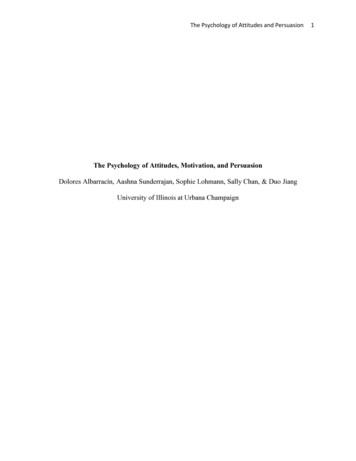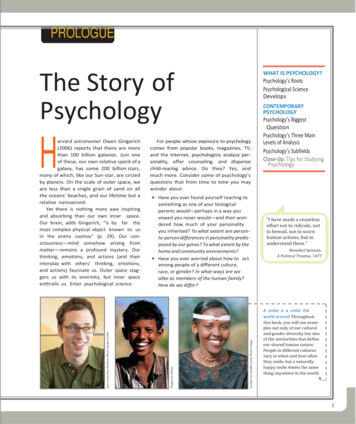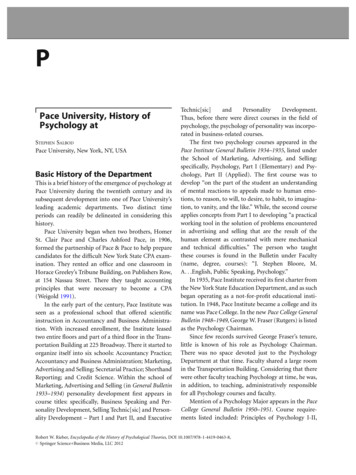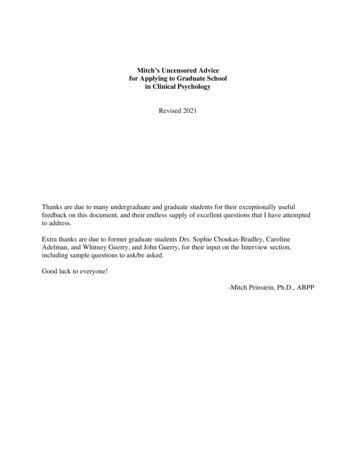
Transcription
The Psychology of Attitudes and PersuasionThe Psychology of Attitudes, Motivation, and PersuasionDolores Albarracín, Aashna Sunderrajan, Sophie Lohmann, Sally Chan, & Duo JiangUniversity of Illinois at Urbana Champaign1
The Psychology of Attitudes and Persuasion2The Psychology of Attitudes, Motivation, and PersuasionA quick look at the front page of the New York Times shows headlines, such as:12 Oscar Nominations for The RevenantSyrians Tell a Life Where Famine is a WeaponCruz Did Not Report Goldman Sacks Loan in Senate RaceWhat to Expect of G.O.P. Debate: Escalating AttacksTerrorists Attacks Kill at Least Two in Jakarta, Police SayEach and every headline connects with attitudes, as evaluations that drive our actions, and insome of these cases, our inactions. Attitudes are not only part of the news consumed worldwide,but are also a subject of general interest that has increased over time. For example, Amazon listsover 30,000 books containing the word attitude in the title, indicating the interest we have inunderstanding, and also changing, attitudes. Similarly, a search for the term attitude, on GoogleScholar and PsycINFO, shows that the topic of attitudes has also continued to increase inpopularity in the academic domain, resulting in a voluminous body of literature on the topic (seeFigure 1).The psychology of attitudes is generally a social psychology of attitudes. Clearly,cognitive psychology has contributed to our understanding of the microprocesses involved inattitude formation and change, and biological psychology can account for the sensorialmechanisms underlying preferences for certain objects, such as foods. There is, however, areason why attitudes have been a focus in social psychology: Attitudes are often learned fromothers, make individuals similar to members of their groups, and are affected by social pressureand persuasion – the act of attempting to change the attitudes of another person. In thisintroductory chapter, we discuss these critical issues regarding the nature of attitudes, addressing
The Psychology of Attitudes and Persuasion3classic and contemporary questions. In doing so, we give you an insight into what theforthcoming chapters of the handbook will cover in more extensive detail, and thus, provide abrief sketch of the general organization of this handbook.As shown in Figure 2, in this chapter we consider attitudes in relation to beliefs,intentions, behaviors and goals, and also discuss the influence of various processes of attitudeformation and change, including persuasive communications. This Handbook includes chapterson beliefs (Wyer, this volume), attitude structure (Fabrigar, MacDonald, & Wegener, thisvolume), communication and persuasion (Johnson, Wolf, & Maio, this volume), the influence ofattitude on behavior (Aizen, Fishbein, Lohmann, & Albarracίn, this volume), motivationalinfluences on attitudes (Earl & Hall, this volume), cognitive processes in attitudes (Wegener,Clark, & Petty, this volume), bodily influences on attitudes (Schwarz & Lee, this volume),neurofunctional influences on attitudes (Corlett & Marrouch, this volume), cultural influences onattitudes (Shavitt, this volume), and attitude measurement (Krosnick, Judd, & Wittenbrink, thisvolume). The second volume presents the many applications of attitude theory conducted within,and outside of, psychology, with chapters on cancer (Sweeny & Rankin, volume 2), HIV(Glasman & Scott-Sheldon, volume 2), dietary behavior (Matta, Dallacker, Vogel, & Hertwig,volume 2), physical activity (Hagger, volume 2), clinical contexts (Penner, Albrecht, Dovidio,Manning, & van Ryn, volume 2), intergroup relations (Dovidio, volume 2), gender (Diekman &Glick, volume 2), social class (Manza, volume 2), science communication (Kahan & Jamieson,volume 2), migrations (Esses, Hamilton, & Gaucher, volume 2), accounting (Nolder & Peecher,volume 2), and environmental behaviors (Milfont & Schultz, volume 2).Attitudes
The Psychology of Attitudes and Persuasion4The definition of an attitude needs to be one that is sufficiently comprehensive to coverthe extent of current literature, and generalizable to remain useful with evolving research trends(Eagly & Chaiken, 2007; Gawronski, 2007). What has been consistent in the multipleconceptualizations of the attitude construct is that evaluation is the key component (Ajzen, 2001;Albarracín, Zanna, Johnson, & Kumkale, 2005; Eagly & Chaiken, 1993; Gawronski, 2007; Maio& Haddock, 2009). Thus, in this chapter we define attitude as evaluation.The target or subject matter of an attitude can be any entity, such as an object, a person, agroup, or an abstract idea. Attitudes towards objects span many applications of socialpsychology, including such domains as marketing (e.g., attitudes towards products), advertising(e.g., attitudes towards ads), political behavior (e.g., attitudes towards political candidates,parties, or voting), and health (e.g., attitudes towards protective behaviors, new medications, orthe health system). Attitudes towards a person or groups are often investigated under theumbrella of interpersonal liking and prejudice. Attitudes towards abstract ideas involve values,such as judging freedom or equality as desirable.Attitudes also vary in terms of specificity vs. generality. An attitude towards DonaldTrump is specific in target (e.g., his hairdo comes to mind), but many attitudes are general. Forexample, some individuals hold relatively positive attitudes towards all objects, whereas othersdislike most objects, people, and ideas (Hepler & Albarracín, 2013). Further, attitudesconcerning an object can have different degrees of specificity with respect to temporal andspatial contexts (see Ajzen & Fishbein, 2005; Fishbein & Ajzen, 1975). For example, receivingthe flu vaccine in the next month represents less commitment than consistently receiving the fluvaccine every fall. Likewise, receiving the flu vaccine in Chicago may seem more desirable thanreceiving the flu vaccine while vacationing in the South Pacific.
The Psychology of Attitudes and Persuasion5Measurement also has implications for distinctions among attitudes (see Krosnick et al.,this volume). The development of attitude measurement techniques, for instance, has enabledresearchers to measure attitudes indirectly rather than relying exclusively on explicit ratings ofliking or approval (Bassili & Brown, 2005; Gawronski, 2007). These indirect measures ofattitudes, referred to as implicit, are intended to assess automatic evaluations that are generallydifficult to gauge using explicit self-reports (see Gawronski, this volume). For example, theeffectiveness of implicit measures is implied by evidence showing that they are ofteninconsistent with (Petty, Fazio, & Briñol, 2009), and predict different outcomes from (Maio &Haddock, 2009), self-reported or explicit attitudes.The divergence between implicit and explicit attitudes has commonly been seen asevidence suggesting that they measure two distinct representations of attitudes, namelyunconscious and conscious processes (Wilson, Lindsey, & Schooler, 2000). Alternatively, thelack of intercorrelation between implicit and explicit attitudes has been used to suggest that eachmeasure captures upstream and downstream processes, specifically automatic responses andintentionally edited judgments related to the same attitude (Fazio, 1995; Nier, 2005). Somescholars have even questioned whether attitudes can be regarded as stable entities, or if they areinstead constructed only when the attitude object is encountered (e.g., Schwarz, 2007). In anattempt to address this debate, Hofmann, Gawronski, Gschwendner, Le and Schmitt (2005)conducted a meta-analysis of 126 studies examining the relation between implicit and explicitrepresentations. In this synthesis, the correlation between the Implicit Association Test (IAT) andexplicit attitude measures was r .24, but varied as a function of psychological andmethodological factors (Hofmann et al., 2005). For instance, the correlation between implicit and
The Psychology of Attitudes and Persuasion6explicit measures varied as a function of the amount of cognitive effort used during explicit selfreport tasks, suggesting different transformations of a single evaluative response.Neuroimaging studies have observed similar differences between implicit and explicitattitudes (see Corlett & Marrouch, this volume). For example, the structures involved duringautomatic evaluations have been found to include the amygdala, the insula, and the orbitofrontalcortex (Cunningham, Johnson, Gatenby, Gore, & Banaji, 2003; Cunningham, Packer, Kesek, &van Bavel, 2009; Cunningham, Raye, & Johnson, 2004; Wright et al., 2008). In contrast, thoseinvolved during controlled evaluations have been found to include regions of the anteriorcingulate cortex, including the dorsal anterior cingulate cortex (Cunningham et al., 2003;Cunningham et al., 2004; Critchley, 2005). Together, these studies suggest that there may also bea neural distinction between the processes engaged during automatic and deliberate processing,and is compatible with the notion that implicit measures capture earlier, spontaneous, affectiveprocesses, whereas explicit attitudes reflect more deliberate adjustments on the basis of currentgoals or social desirability concerns.Behavior, Beliefs, Intentions, and GoalsA few additional concepts central to the psychology of attitudes and persuasion includebehavior, intentions, goals and beliefs. Behavior is typically defined as the overt acts of anindividual (Albarracín et al., 2005) and is generally assumed to partly stem from attitudes.Considerable research on the attitude-behavior relation indicates that attitudes are fairly goodpredictors of behaviors. For example, a meta-analytic review of the literature has found that theaverage correlation between attitudes and behavior is r .52 (Glasman & Albarracίn, 2006), andthat this association varies with a number of established moderators (see Ajzen et al., thisvolume).
The Psychology of Attitudes and Persuasion7An intention is a willingness to perform a behavior. Intentions often emerge frombroader goals – desirable endstates – that can be achieved via multiple, sustained behaviors, arenot fully controllable results, and require external help or resources (Ajzen & Fishbein, 2005).For example, people develop intentions to increase physical activity with the goal of losingweight, but executing the intended behavior is no guarantee of success.Like attitudes, goals can be specific or general. On the one hand, attitude-behaviorresearchers have generally studied fairly specific goals, such as the goal to quit smoking (seeAjzen & Fishbein, 1980). When set, these goals are facilitated by intentions to perform specificactions, like throwing away smoking related paraphernalia or avoiding friends who smoke. Theintention to quit smoking or achieve a similar goal is an excellent predictor of actual behavior.For example, meta-analyses of specific health behaviors, such as condom use and exercise, haveyielded average intention-behavior correlations ranging from .44 to .56 (Albarracín, Johnson,Fishbein, & Muellerleile, 2001; Godin & Kok, 1996; Hausenblas, Carron, & Mack, 1997;Sheeran & Orbell, 1998). On the other hand, traditional goal researchers have studied moregeneral goals, such as the achievement motivation or the affiliation need (Elliot & Church, 1997;Maslow, 1970). These goals have a weak correspondence to specific behaviors, probablybecause they are carried out over long periods of time and across many domains. For example,achievement or affiliation motivations correspond to personality or stable patterns of behavior(for a recent review, see Moskowitz, Li, & Kirk, 2004), and can either be measured ormanipulated with methods borrowed from cognitive psychology (e.g., presenting semanticallylinked words; see Hart & Albarracín, 2009; Weingarten et al., 2015). Perhaps the most generalclass of all investigated goals (see Albarracín et al., 2008; Albarracín, Hepler, & Tannenbaum,2011) entails general action goals, which are generalized goals to engage in action (e.g.,
The Psychology of Attitudes and Persuasion8activated with instructions such as go), as well as general inaction goals, which are generalizedgoals not to engage in action (e.g., activated with instructions such as rest). These goals arediffuse desired ends that can mobilize the execution of more specific activities. Action goalsimply a need to do irrespective of what one does; inaction goals imply a need to not do,irrespective of the domain. Hence, their activation may trigger the pursuit or interruption of anyparticular (overt or covert) behavior that is subjectively relevant to the goal.A belief can be defined as a person’s subjective probability of a relation between theobject of the belief and some other object, value, concept, or attribute, and affects people’sunderstanding of themselves and their environments (Fishbein & Ajzen, 1975). Aconceptualization proposed by McGuire (1960, 1981) and extended by Wyer and Goldberg(1970; see also Wyer, 1974) addressed how prior beliefs can influence new beliefs and attitudes.McGuire (1960) stated that two cognitions, A (antecedent) and C (conclusion), can relate to eachother by means of a syllogism of the form A; if A, then C; C. This structure implies that theprobability of C (e.g., an event is good) is a function of the beliefs in the premise or antecedent,and beliefs that if A is true and if A is true, C is true. Further, Wyer (1970; Wyer & Goldberg,1970) argued that C might be true for reasons other than those included in these premises. Thatis, beliefs in these alternate reasons should also influence the probability of the conclusion (notA; if not A, then C). Hence, P(C) should be a function of the beliefs in these two mutuallyexclusive sets of premises, or:P(C) P(A)P(C/A) P( A)P(C/ A),[1]where P(A) and P( A) [ 1-P(A)] are beliefs that A is and is not true, respectively, and P(C/A)and P(C/ A) are conditional beliefs that C is true if A is and is not true, respectively.
The Psychology of Attitudes and Persuasion9A limitation of the conditional inference model described above is the use of a singlepremise. Although other criteria are considered, these criteria are lumped together in the value ofP(C/ A), or the belief that the conclusion is true for reasons other than A. In contrast, otherformulations consider multiple factors. Slovic and Lichtenstein (1971), for example, postulatedthat people who predict an unknown event from a set of cues are likely to combine these cues inan additive fashion. Therefore, regression procedures can be used to predict beliefs on the basisof the implications of several different pieces of information. In this case, the regression weightsassigned to each piece provide an indication of its relative importance.Multiple-regression approaches can be useful in identifying individual differences in theweights given to different types of cues (Wiggins, Hoffman, & Taber, 1969). Nevertheless, theassumptions that underlie these approaches are often incorrect (Anderson, 1971, 1981; Fishbein& Ajzen, 1975; Wiggins & Hoffman, 1968). Birnbaum and Stegner (1979), for example, foundthat participants’ estimates of a car’s value was an average of its blue book value and the opinionof another person, with the weight of each piece of information depending on the credibility ofits source.In many instances, however, neither summative nor averaging belief models may beapplicable. Tversky and Kahneman (1983) provide strong evidence that people’s estimates of theconjunction of two features (e.g., the likelihood that a woman is a feminist bank-teller) are notpredictable from their estimates of each feature considered in isolation (i.e., being a feminist orbeing a bank teller). In these instances, people appear to process the information configurallyrather than construing the implications of each piece of information separately. The conditions inwhich different combinatorial processes underlie the beliefs that people report (as well as otherjudgments they make) require more detailed analyses than can be provided in this chapter (for a
The Psychology of Attitudes and Persuasion 10general discussion of these matters, see Wyer, this volume; Wyer & Albarracin, 2005; Wyer &Carlston, 1979).Further Characterizing AttitudesAttitude StructureThe structure of an attitude can be explicated using models of affective feelings. Apopular understanding of the structure of affect and emotions incorporates the dimensions ofpositive vs. negative valence and high vs. low arousal (Bradley, Codispoti, Cuthbert, & Lang,2001; Russell, 2003; Smith & Ellsworth, 1985; for reviews, see Albarracín & Vargas, 2010;Clore & Schnall, this volume; Schimmack & Crites, 2005). People feel sad, angry, content, orexcited, and each state varies not only in negative or positive valence but also in associatedarousal (Russell, 2003). Arousal has proved to be difficult to describe, but generally entailsautonomic activation measurable by changes in skin conductance, heart rate, or brain waves (seeBradley & Lang, 2007; Cacioppo, Berntson, & Crites, 1996). Feeling anxious, tense, alert, andexcited have high autonomic activation or arousal in common (e.g., high heart and breathingrate), whereas feeling sad and content have low autonomic activation or arousal in common (e.g.,lower heart and breathing rate; somnolence).As evaluations are valenced responses (positive vs. negative), attitudes can also bemapped onto a model with valence and arousal as distinct dimensions (Albarracín & Vargas,2010). This model appears in Figure 3. On the valence axis, individuals may dislike or like apolitical candidate, and may dislike or like a particular taste. Furthermore, attitudes can bemapped onto the arousal dimension because they vary in extremity, importance, confidence, orthe degree to which they elicit strong emotional responses, such as excitement (see Cuthbert,Schupp, Bradley, Birbaumer, & Lang, 2000; Fabrigar, MacDonald, & Wegener, 2005; Lang,
The Psychology of Attitudes and Persuasion 11Öhman, & Vaitl, 1988). For example, highly involving objects such as abortion, gay marriage,and marijuana legalization often trigger strong attitudes that are infused with feelings, andconnect to other important attitudes, such as personal values and self-esteem (the evaluations ofoneself as a person; Eagly & Chaiken, 1993; Fabrigar et al., 2005). These attitudes are oftenreported as extreme in responses to attitude scales (Judd & Brauer, 1995), are held with highconfidence (Abelson, 1988), are easy to recall (Judd & Brauer, 1995), and are passionatelydefended against external attacks (Johnson, Maio, & Smith-McLallen, 2005; Petty, Tormala, &Rucker, 2004). We review some of this evidence in upcoming sections of this chapter.Adhering to a valence/arousal model does not require adherence to a circumplex (see alsoRemington, Fabrigar, & Visser, 2000). For instance, objects with either extremely positive orextremely negative valence are often important and generate high autonomic arousal (for areview, see Bradley et al., 2001). In this case, high positive and negative valences go along withhigh arousal, whereas neutral valences go along with low arousal. Mapping objects ontoindependent valence and arousal dimensions would thus produce a U-type of pattern, rather thanequally populated quadrants (see Bradley et al., 2001; Remington et al., 2000).Neuropsychological research indicates that specific structures in the brain respond tostimuli in ways that suggest an intricate relation between valence and arousal. As one case inpoint, the amygdala, an almond-shaped group of neurons located deep in the medial temporallobes of the brain, plays a critical role in evaluation (Hamann, Ely, Hoffman, & Kilts, 2002;Irwin et al., 1996). The amygdala is active during affective judgments of emotional pictures,words, and odors (Cunningham et al., 2004; Phan et al., 2004; Royet, Plailly, Delon-Martin,Kareken, & Segebarth, 2003), when there are negative (vs. positive) stimuli (Cunningham et al.,2003; Morris et al., 1996; Reekum et al., 2007), and when the stimuli have emotional meaning
The Psychology of Attitudes and Persuasion 12(Bechara, Damasio, Damasio, & Lee, 1999). Also, the amygdala connects with the insula and theanterior cingulate cortex, and these three structures all respond to both valence and arousal(Cunningham et al., 2004; Cunningham & Zelazo, 2007; Rempel-Clower, 2007; Wright et al.,2008). The visual cortex also appears sensitive to both valence and arousal, as judged from anfMRI study revealing greater activation in response to pleasant and unpleasant images, comparedto neutral images (Lang et al., 1998).Attitude BasesAttitudes are based on affective, cognitive, and behavioral information (Albarracín et al.,2005; Eagly & Chaiken, 1993). The affective component consists of feelings and emotionsrelated to an attitude object, the cognitive component is composed of beliefs, thoughts, andattributes associated with an attitude object, and the behavioral component comprises of pastbehaviors or experiences with an attitude object (Eagly & Chaiken, 1993; Fabrigar et al., 2005,this volume).Although earlier attitude research conceptualized cognitive, affective, and behavioralcomponents as facets of attitudes, there is now consensus that these are the bases for attitudeswithout being attitudes themselves. Breckler (1984), for example, had participants report theircognitive, affective, and behavioral responses about snakes. Using the content of participants'responses, Breckler then computed a score for each of the components and found that they wereempirically distinct. Equally important, however, cognitive, affective, and behavioral measuresseparately predict attitudes. Haddock, Zanna and Esses (1994) examined the attitudes ofCanadian students towards Native Canadians. Using open-ended measures of cognition, affect,and behavior, the researchers found that participants' past experience with Native Canadianspredicted their attitudes, independently of cognition and affect.
The Psychology of Attitudes and Persuasion 13Attitude FunctionsAttitudes can serve different motives and functions for individuals. The earliest, and mostprominent, functional theories proposed were by Smith, Bruner and White (1956) and Katz(1960). Although these theories differ in the labels they use, they both see attitudes as constructsdesigned to serve an individual’s social and emotional needs (Shavitt & Nelson, 2002; for areview, see Kruglanski & Stroebe, 2005). Katz (1960), for example, proposed that attitudes servefour functions. The knowledge function represents attitudes that organize information about theenvironment. The utilitarian function reflects attitudes that summarize the rewards andpunishments associated with an attitude object. The ego-defensive function embodies attitudesthat protect the self. Finally, the value-expressive function represents attitudes that express anindividual’s self-concept. Smith et al. (1956) additionally proposed a social-adjustmentfunction, which reflects attitudes that help to identify with those we like and de-identify withthose we dislike.In recent years, research on the function of attitudes has focused on the more specificfunctions that attitudes serve (Maio & Haddock, 2009). In particular, functional theories haveseen a resurgence in persuasion literature, where they have been important in emphasizing thenecessity of understanding the motivational basis of the attitudes we strive to change (Shavitt &Nelson, 2002). Research in advertising has found that the use of functionally matched ads elicitsmore favorable attitudes and purchase intentions, compared to functionally mismatched ads(Shavitt, 1990), and that this effect persists when individuals are asked to write their own ads(Shavitt, Lowrey, & Han, 1992). Similarly, research in the domain of health behavior has foundthat attitude functions can serve as determinants of behavioral intentions with respect to regularlyparticipating in physical activity (Wang, 2009) and registering as an organ donor (Wang, 2012).
The Psychology of Attitudes and Persuasion 14The literature in the functional area is, however, still lacking (Maio & Olson, 2000;Shavitt & Nelson, 2002). One reason is that individuals are often poor at identifying thefunctional reasons behind their attitudes (Maio & Haddock, 2009; Nisbett & Wilson, 1977). Asecond is that attitude functions are not always distinct, making the categorization of attitudesinto separate functional types difficult (Maio & Haddock, 2009). Despite these challenges,research in this area is sure to thrive in the next decade, as functional theories are necessary toshed light on the motivational basis behind attitudes and behavior.Attitude DimensionsAttitude strength is the degree to which an attitude persists over time, is resistant tochange, and influences cognitions and behavior (Fazio, 1995; Krosnick & Smith, 1994).Therefore, the strength with which an attitude is held informs us of when and which type ofattitudes are predictive of behavior. In the literature, attitude strength is seen as a combination ofmultiple dimensions (including extremity, intensity, certainty, importance, interest, knowledge,accessibility, and affective-cognitive consistencies), which interact to influence theconsequentiality of attitudes. Initially, as these dimensions predicted most of the features ofstrong attitudes, they were seen as forming a single construct, namely attitude strength (Miller &Peterson, 2004). Exploratory factor analyses provided evidence for this assertion, by determiningthat the different dimensions of attitude strength could be grouped under a few factors (Bassili,1996). However, due to problems with measurement error, some argued that these conclusionswere exaggerated (Krosnick, Boninger, Chuang, Berent, & Carnot, 1993). Krosnick et al. (1993),in fact, found that only a few pairs of dimensions were strongly correlated with each other. Thisleads to the position that attitude strength is not a unitary construct, but rather, consists of
The Psychology of Attitudes and Persuasion 15multiple dimensions (Krosnick et al., 1993; Miller & Peterson, 2004; Visser, Krosnick, &Simmons, 2003).As space constraints prevent us from describing every dimension associated with attitudestrength, we focus on a few properties and some associated findings: extremity, importance,certainty, and accessibility (for reviews, see Bassili, 2008; Farbrigar et al., this volume; Krosnicket al., 1993; Krosnick & Smith, 1994; Miller & Peterson, 2004). Attitudes vary in direction,ranging from positive to negative. Attitude extremity is thus the degree to which an individual’sattitude deviates from neutrality in either a positive or negative direction (Bassili, 2008; Krosnicket al., 1993; Krosnick & Smith, 1994). A polarization in attitude can be caused by severalprocesses, including activation of the attitude via thoughts (Tesser, Martin, & Mendolia, 1995)and attitude repetition (Judd & Brauer, 1995). Insults have also been shown to increase attitudeextremity (Abelson & Miller, 1967), with recent work suggesting that arguments against the selftrigger an ego-defensive mechanism that can lead to attitude polarization (De Dreu & vanKnippenberg, 2005).Attitude importance is characterized by the degree to which an individual is personallyinvested in an attitude (Bassili, 2008; Krosnick et al., 1993; Krosnick & Smith, 1994) andmanifests itself in self-reported caring about the attitude object. The more important an attitudeis, the more it is resistant to change and stable over time (Krosnick & Smith, 1994). Attitudesthat are important also lead to selective exposure and elaboration of attitude-relevant information(Holbrook, Berent, Krosnick, Visser, & Boninger, 2005).Attitude certainty is the degree to which an individual is confident in the attitude theyhold (Krosnick et al., 1993; Krosnick & Smith, 1994). Unlike many of the other dimensions,attitude certainty is a metacognitive attribute, as it attaches an explanation of certainty onto a
The Psychology of Attitudes and Persuasion 16primary cognition (Petty, Briñol, Tormala, & Wegener, 2007). Certainty in one's attitude isdetermined by such factors as direct experience (Wu & Shaffer, 1987) and repetition (Holland,Verplanken, & van Knippenberg, 2003); certainty confers resistance to persuasive messages(Krosnick & Smith, 1994).Research suggests that a unifying framework of attitude strength is attitude accessibility(Ajzen, 2012). Accessibility refers to the strength of the association between an attitude objectand its evaluation and is observed as the ease with which an attitude is activated from memory atthe appearance of the attitude object (Fazio, Sanbonmatsu, Powell, & Kardes, 1986).Accessibility is partly determined by the frequency with which an attitude is activated, as well asthe perceived diagnosticity of the information regarding an attitude, which includes theemotional reaction elicited by the attitude object, prior experience with and behavior towards theattitude object, and the foundation upon which the information is obtained (e.g., if it’s based onsensory information or direct experience; Fazio, 1995).In addition to studies looking at the dimensions of attitude strength in isolation, therehave been studies that have tried to explore attitude strength within a social context, includingthe heterogeneity of an individual’s social network (Levitan & Visser, 2009; Visser & Mirabile,2004). For example, Visser and Mirabile (2004) found that the composition of an individual'ssocial network can affect the strength of their attitudes, with those embedded in moreheterogeneous networks being more susceptible to persuasive messages. This finding highlightsthe social
The Psychology of Attitudes and Persuasion 2 The Psychology of Attitudes, Motivation, and Persuasion A quick look at the front page of the New York Times shows headlines, such as: 12 Oscar Nominations for The Revenant Syrians Tell a Life Where Famine is a Wea










